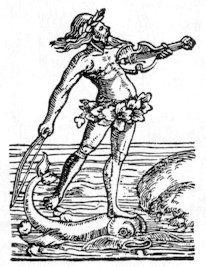Paracelsus and Oporinus
Today, we meet a printer and an alchemist. The University of Houston's College of Engineering presents this series about the machines that make our civilization run, and the people whose ingenuity created them.
I've spoken before of Paracelsus. This quixotic knight of early science draws me like flame draws a moth. Born in Switzerland the year Columbus sailed to America, Paracelsus became a wandering scholar. He spoke the language of magic and alchemy. Yet he transmuted that tongue even as he spoke it.
Paracelsus had a special interest in medicine. He wrote voluminously. He boasted. He tore into his opponents. He made enemies. If we only glance at him, we see a quarrelsome mountebank. But let's look more closely. Then we can see substance.
People would speak of white magic and black magic. "No!" roared Paracelsus, "There is only one magic." Good or evil vests in the practitioner, not the art. He used the word magic. But when he shifted moral responsibility to the magician, magic became another word for the powers of nature. In that sense, he practiced modern science. He even hinted at modern psychiatry.
Paracelsus demanded a new level of observation in medicine. In 1527 he built a bonfire at the University in Basel. Into it he flung Galen's classic Roman medical text. He condemned the old scholastic medicine. He told doctors that their eyes and their heads would teach them what Galen could not.
By now Paracelsus had a disciple. He was the young printer Oporinus. They made an odd couple. Paracelsus almost killed Oporinus by experimenting on him. Oporinus honored Paracelsus's abilities. He also wrote that he was irreverent, a glutton, and a drunk. Paracelsus wrote about "faithful Oporinus."
Paracelsus finally brought such chaos on himself that Oporinus had to leave him. Yet he was finally instrumental in completing Paracelsus's agenda of medical reform.
The year Paracelsus threw the old text on the fire, a young boy in Flanders, Andreas Vesalius, was preparing to study medicine. Vesalius soon raised the same objections in Italy. He went on to write the first modern text on anatomy.
Vesalius really threw Galen into the fire. He corrected over 200 major errors in the old standard. Then he went to a student of Titian to illustrate the work.
Finally, two years after Paracelsus died, Vesalius called on Oporinus to print his book. He'd picked the right person. Oporinus understood what this manuscript was. He printed one of the most beautiful and important books of all time. That book changed medicine forever.
Oporinus had played Sancho Panza to Paracelsus's Quixote. But it had not been in vain. The master's squire had, at last, helped to tumble the windmill of outdated medicine.
I'm John Lienhard, at the University of Houston, where we're interested in the way inventive minds work.
(Theme music)
Pachter, H.M., Paracelsus: Magic Into Science. New York: Henry Schuman, 1951.
Boorstin, D.J., The Discoverers. New York: Random House, 1983, Chapter 46.
Debus, A.G., The English Paracelsians. New York: Franklin Watts, Inc., 1966, Chapter I.
For more on Paracelsus, see Episode 511. Oporinus studied with another great Swiss printer, Frobenius or "Froben." Froben was Erasmus's printer and Paracelsus's benefactor. Unfortunately he died just after the bonfire incident.
For more on Vesalius, see Episode 325. See also Boorstin (above) or Nuland, S.B., Doctors: The Biography of Medicine. New York: Vintage Books, 1988.
Vesalius, A., De Humani Corporis Fabrica Libri Septum. 1543. (Several facsimile publications are available. Check your library.)

clipart
Oporinus's printer's device